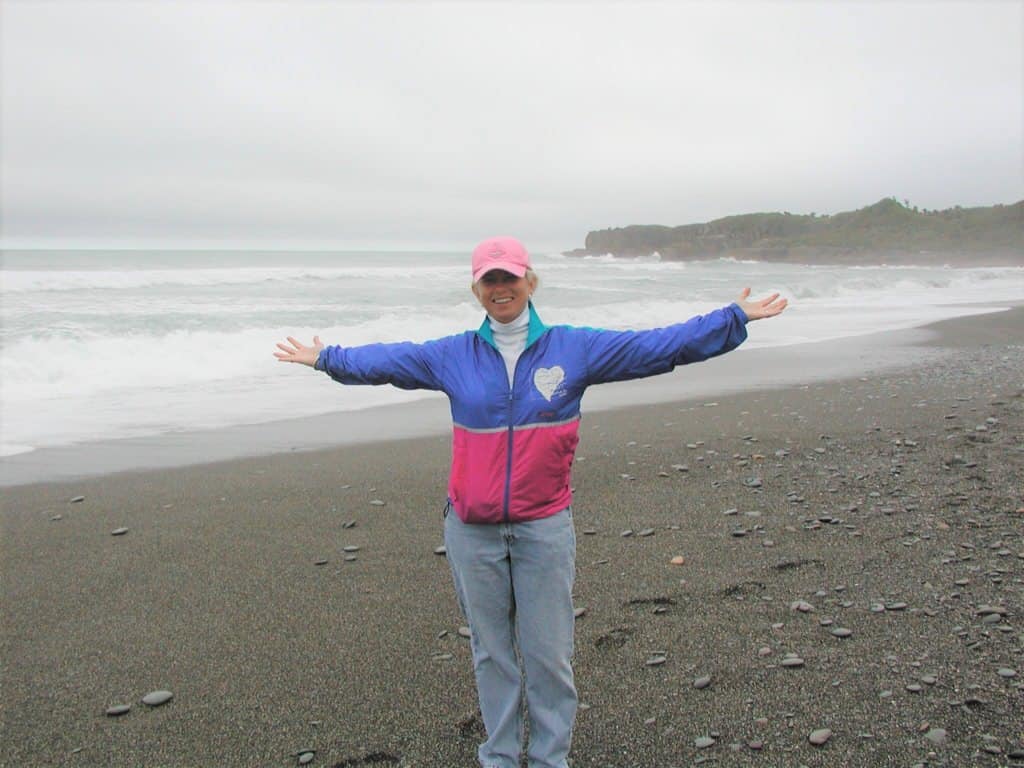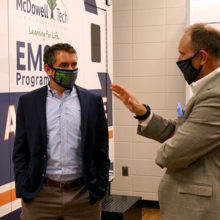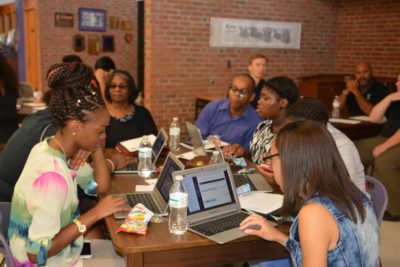

In October I went to the North Carolina Barbecue Festival in Lexington. Everywhere I turned I saw homemade t-shirts and signs in support of then-candidate Donald Trump. I was surprised to not see signs in support of other Republican candidates or any Democratic candidates on the state or federal level.
I called Mebane Rash on my way home to discuss a phenomena that was unlike anything I had seen in electoral politics. She told me then that she had seen a substantial amount of homemade signs in support of the Trump-Pence campaign along rural byways and explained that homemade signs were one of her measures of the strength of a political campaign.
While questions continue to bubble up about the variances between polling and results, and whether it was the data or journalists explaining the data that missed the mark, we wondered what had been missed about the lived reality of North Carolinians in the run-up to the election and the aftermath and why.
What voices are being left out of news coverage driven by an increasingly national press corps that are housed in major metropolitan areas, primarily along the coasts of the United States?
We began to discuss how to increase our own access to the voices of those left out of the mainstream media coverage and how to reach those voices with the content that we created. We can imagine content driven by data that we would collect from North Carolinians en masse. Content that includes us diving deeply into stories identified through surveying, policy analysis driven by their voices, and ultimately content created by …. y’all.
We thought of it as the Architecture of Participation 2.0 — the next evolution of the heartbeat of EdNC and mission-based journalism with a side of citizen engagement.
Idea to reality
The reality of mission-based work is that ideas, even good ones, remain on the drawing board without funding.


So it was a bit of serendipitous timing that led to Kathy Higgins, the Vice President of Corporate Affairs for Blue Cross and Blue Shield of North Carolina (BCBSNC) and President of the Blue Cross and Blue Shield of North Carolina Foundation, and I having lunch in the midst of brainstorming the future of EdNC. Kathy spoke at length about her Eisenhower Fellowship experience in Australia and New Zealand which had led her to a group called Parents’ Voice, the online network of parents who are interested in improving the food and activity environments of Australian children who have had substantial offline impacts.


Parents’ Voice, originally known as Parents’ Jury, began in 2004 and now represents thousands of Australian parents. They have used nutritionists and dietitians to do analyses of food for children and school menus, surveys of parents to shine a light on ad campaigns aimed at children and their food choices, and more.
Their communications platform has proven powerful because it truly represents the voice of the parents.
Kathy shared that she had spent time evaluating different organizations who might want to become the home of North Carolinian voices, push the boundaries of communication, and work to bring more context and understanding to people and policymakers alike.
Why EdNC?
The work of improving your community, just like the work of improving yourself, begins with understanding. And to understand requires context and explanation.
I’ve been privileged enough to be part of EdNC.org from the early days, and I believe that we have worked diligently to build a platform for knowledge for our entire state.
In those early meetings Gerry Hancock and Ferrel Guillory, our founders, spoke often of the decline of state level policy reporting. They reminded us of the essential role of journalism to provide a trusted source for information and to serve as a watch dog. They spoke to us about the need to be transparent, and they made clear that journalism, at its best, would serve as a voice for the voiceless.
The call to be a voice for the voiceless was one of the moments of inspiration for what came to be called the EdNC Architecture of Participation.
Our Architecture of Participation is founded on our belief in two-way communication and the inherent power of conversation.
New communication channels are more of a return to an earlier age where news was spread around campfires and communal gatherings as opposed to one-way communication that became the norm first through radio and later through television.
Recently, Mebane and I met with a group of business leaders, and as we explained the promise of digital media, I reminded them that the new communication channels are more of a return to an earlier age where news was spread around campfires and communal gatherings as opposed to one-way communication that became the norm first through radio and later through television.
The return to the roots of communication will make it possible for the voiceless to now be heard at scale.
EdNC has published more than 375 unique voices through our platform including students, parents, educators, aspiring educators, administrators, policymakers, and philanthropists. Those voices have contributed to more than 1,650 pieces. Some of those pieces have influenced policy debates at the N.C. General Assembly, others have been printed off and taken to school board meetings as background for a request.
And as Mebane mentioned in her recent article on EdNC’s growth and future, the Architecture of Participation determines how we measure impact which is based largely around our key engagement measure — sharing.


We do not want the conversation to happen on our social accounts or website alone, we want the conversation to happen in your world — whether that means in the break room at your school, your table at the local diner, or on your Facebook feed.
On our end, the Architecture of Participation requires us to publish information where you are. We are experimenting with Facebook Instant Articles, cross-publishing content on Medium, live-tweeting and then capturing the tweets as opposed to recaps that post the next day, and live video. And, as always, anyone can like us on Facebook, follow us on Twitter, and subscribe to our newsletter to receive information where you are.
That is why I believe that we were well situated in the eyes of Kathy, and the entire Blue Cross and Blue Shield of North Carolina team, to take on the challenge of building a larger Architecture of Participation that would bring your voice forward.
We hope that you will join us as we build out this work in 2017.
A personal note
This project is in many ways the outgrowth of research that began years ago as I dove head first into questions around the decline of the local media, the rise of social media, and my own belief in the power of communication to bring about change.
As a teenager in Caldwell County, logging on the internet from a dial-up 56k connection, I began to feel connected to a broader world and to big, hairy questions.
I had often wondered about the ravages of addiction, the underlying social issues that caused poverty to be generational far too often, and other issues that impacted both my immediate and broader family. Teachers were kind to answer my questions, librarians often directed me to reference materials, but it was the internet that taught me that I was not alone.
One of the challenges of statewide, or national, policymaking is the disconnect between those making decisions and the public in public policy. I learned that from a young age as I watched factories disappear from Caldwell County, noticed the rise of opioid addiction long before they hit the page of the Washington Post, and wondered whether anyone cared.
It is my hope that in a big way this project will begin to close the gap between people and policy so that all of us will be better off.
Please join us.
Editor’s Note: Thank you all for engaging with Reach NC Voices as we launched this initiative yesterday. Your feedback is really helpful.
Reach NC Voices will be a multi-month effort, reaching hundreds of thousands of North Carolinians through online news, social media, and text messaging. We will be piloting new technology every step of the way. Yesterday and today, we included short audience polls in the articles to test an online survey format. Later polling will be conducted across thousands of respondents and include statistical analysis to produce validated results. We also will conduct some focus groups on the ground, in-person — as many of you have suggested.


